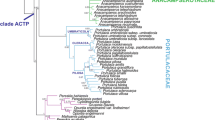Abstract
The karyomorphology of 16 species in 13 genera representing Moraceae and Cecropiaceae was investigated in an effort to contribute to a better understanding of chromosome features and evolution in the families. All genera investigated have similar karyomorphology, but differences are found in (1) chromosome features of Interphase nucleus (simple, simple-complex, or complex chromocenter type), (2) basic chromosome number (x=13 or 14), (3) size variation (mono-or bimodial), and (4) frequencies of chromosomes with median centromeres (m-chromosome) (25–85%) and those with subterminal (or terminal) centromeres (st-chromosome) (14–69%). Comparisons with Ulmaceae as an outgroup of the remainder of Urticales suggest that the simple chromocenter type,x=14 comprising bothm- andst-chromosomes, and the monomodial karyotype are plesiomorphies in Moraceae and Cecropiaceae. Most of Moraceae and Cecropiaceae retain generalized chromosome features of the order, but have involved a few evolutionary changes in karyomorphology. Based on some detailed karyomorphological data, inter- and infrafamilial relationships are also briefly discussed.
Similar content being viewed by others
References
Bawa, K.S. 1973. Chromosome numbers of tree species of a lowland tropical community. J. Arnold Arbor.54: 422–434.
Berg, C.C. 1989. Systematics and phylogeny of the Urticales.In P.R. Crane and S. Blackmore, eds., Evolution, systematics and Fossil History of the Hamamelidae. Volume 2: ‘Higher’ Hamamelidae. Systematic Association Special Volume40B: 193–220.
Bir, G.S., Gill, B.S. andBedi, Y.S. 1984. Cytological studies in some western Himalayan woody species. I. Gamoperalae and Monochlamydae.In G.S. Paliwal, ed., The Vegetational Wealth of the Himalayas: 483–496. Puja Publishers, Delhi.
Bowden, W.M. 1940. Diploidy, polyploidy, and winter hardiness relationships in the flowering plants. Amer. J. Bot.27: 357–371.
Bowden, W.M. 1945. A list of chromosome numbers in higher plants. II. Menispermaceae to Verbenaceae. Amer. J. Bot.32: 191–202.
Condit, I.J. 1928. Cytological and morphological studies in the genusFicus. I. Chromosome number and morphology in seven species. Univ. California Publ. Bot.11: 233–244.
Condit, I.J. 1933. Cytological and morphological studies in the genusFicus. II. Chromosome number and morphology in thirty-one species. Univ. California Publ. Bot.17: 61–74.
Fedrov, A.A. 1974. Chromosome Numbers of Flowering Plants. English ed. Otto Koeltz, Koeningstein.
Goldblatt, P. 1981–1988. Index to Plant Chromosome Numbers. Volumes for 1975–1978, 1979–1981, 1982–1983 and 1984–1985 published in 1981, 1984, 1985 and 1988, respectively. Monogr. Syst. Bot. Missouri Bot. Gard.5: 1–553;8: 1–427;13: 1–224,23: 1–264.
Goldblatt, P. andJohnson, D.E. 1990–1991: Index to Plant Chromosome Numbers. Volumes for 1986–1987 and 1988–1989 published in 1990 and 1991, respectively. Monogr. Syst. Bot. Missouri Bot. Gard.30: 1–243;40: 1–238.
Grudzinskaya, I.A. 1967. Ulmaceae and reasons for distinguishing Celtidaceae as a separate family Celtidaceae Link. Bot. Zhur.52: 1723–1748 (In Russian with English summary).
Hans, A.S. 1972. Cytomorphology of arborescent Moraceae. J. Arnold Arbor.53: 216–225.
Hsu, C.-C. 1967. Preliminary chromosome studies on the vascular plants of Taiwan (i). Taiwania13: 117–130.
Humphries, C.J. and Blackmore, S. 1989. A review of the classification of the Moraceae.In P.R. Crane and S. Blackmore, eds., Evolution, Systematics and Fossil History of the Hamamelidae. Volume 2: ‘Higher’ Hamamelidae. Systematic Association Special Volume40B: 267–277.
Krause, O. 1930. Cytologische Studien bei den Urticales. Ber. Deutsch. Bot. Ges.48: 9–13.
Krause, O. 1931. Zytotaxonomische Untersuchungen bei den Urticales unter besonderer Berücksichtigung der GatungDorstenia. Planta13: 29–84.
Kubitzki, K., Rohwer, J.G. andBittrich, V. 1993. Flowering Plants Dicotyledons.In K. Kubitzki, ed., The Families and Genera of Vascular Plants. II. Springer-Verlag, Berlin.
LeCoq, C. 1963. Contribution à l'etude cytotaxinomique des Moracées et des Urticacées. Rev. Gen. Bot.70: 869–873.
LeCoq, C. 1964. Étude cyto-taxinomique de six Moracées. Bull. Mus. Natl. Hist. Nat.36: 869–873.
Levan, A., Fredga, K. andSandberg, A.A. 1964. Nomenclature for centromeric position of chromosomes. Hereditas52: 201–220.
Löve, Á. andKjellqvist, E. 1974. Cytotaxonomy of Spanish plants. III. Dicotyledons: Salicaceae-Rosaceae. Lagascalia4: 3–32.
Mehra, P.N. 1976. Cytology of Himalayan Hardwoods. Sree Saraswaty Press, Calcutta.
Mehra, P.N. andGill, B.S. 1974. Cytological studies in Ulmaceae, Moraceae and Urticaceae. J. Arnold Arbor.55: 663–677.
Mehra, P.N. andHans, A.S. 1972. Comparison of diploid and natural polyploid hardwoods. J. Indian Bot. Soc.51: 319–325.
Moore, R.J. 1973–1977. Index to Plant Chromosome Numbers. Volumes for 1967–1971 and 1972 published in 1973 and 1974. Oosthoek's Uitgesversmaatsschappij B.V., Utrecht; Volume 1973/1974 published in 1977, Bohn, Scheltema & Holkema, Utrecht.
Morawetz, W. and Samuel, M.R.S. 1989. Karyological patterns in the Hamamelidae.In P.R. Crane and S. Blackmore, eds., Evolution, Systematics and Fossil History of the Hamamelidae. Volume 1: Introduction and ‘lower’ Hamamelidae. Systematics Association Special Volume40A: 129–154.
Nevling, L.I. 1969. Ecology of an elfin forest in Puerto Rico. 3. Chromosome numbers of some flowering plants. J. Arnold Arbor.50: 99–103.
Oginuma, K., Ibarra-Manriquez, G. andTobe, H. 1992. Chromosomes ofTuxtla pittieri (Asteraceae; Heliantheae). Acta Phytotax. Geobot.43: 135–137.
Oginuma, K., Raven, P.H. andTobe, H. 1990. Karyomorphology and relationships of Celtidaceae and Ulmaceae (Urticales). Bot. Mag. Tokyo103: 113–131.
Ohri, D. andKhoshoo, T.N. 1987. Nuclear DNA contents in the genusFicus (Moraceae). Pl. Syst. Evol.156: 1–4.
Sanjappa, M. andDasgupta, A. 1981.In Chromosome number reports LXXI. Taxon30:508–509.
Sanjappa, M. andRaju, R. 1980.In Chromosome number reports LXVI. Taxon29: 164.
Sotoguchi, H., Tobe, H., Ohba, H. andOkazaki, M. 1993. Silicon-accumulating idioblasts in leaves of Cecropiaceae (Urticales). J. Plant Res.106: 327–335.
Subramanian, D. andThilagavathy, A. 1988. Cytotaxonomical studies in South Indian Urticaceae. Cytologia53: 671–678.
Sugiura, T. 1931. A list of chromosome numbers in angiospermous plants. Bot. Mag. Tokyo45: 353–355.
Sugiura, T. 1936. Studies on the chromosome numbers in higher plants, with special reference to cytokinesis. Cytologia7: 544–595.
Sweitzer, E.M. 1971. Comparative anatomy of the Ulmaceae. J. Arnold Arb.52: 523–585.
Tanaka, R. 1971. Types of resting nuclei in Orchidaceae. Bot. Mag. Tokyo84: 118–122.
Tanaka, R. 1980. The karyotype.In H. Kihara, ed., Plant Genetics.I: 335–358. Shokabo Book Co., Tokyo (In Japanese).
Terabayashi, S. 1991. Vernation patterns in Celtidaceae and Ulmaceae (Urticales), and their evolutionary and systematic implications. Bot. Mag. Tokyo104: 1–13.
Thorne, R.F. 1992. An updated phylogenetic classification of the flowering plants. Aliso13: 365–389.
Author information
Authors and Affiliations
Rights and permissions
About this article
Cite this article
Oginuma, K., Tobe, H. Karyomorphology of some Moraceae and Cecropiaceae (Urticales). J. Plant Res. 108, 313–326 (1995). https://doi.org/10.1007/BF02344357
Received:
Accepted:
Issue Date:
DOI: https://doi.org/10.1007/BF02344357




